
 |
| Michael
Harrison & Kendal Heyes: A Cool Breeze at Dawn Blair French |
||
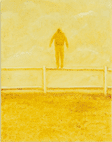 Kendal Heyes, Untitled |
Reading recently a meandering introductory section to a new book of essays on contemporary art by the German curator/critic Wilfried Dickhoff I was struck by the following assertion: “In every true work of art there is a place where the person who can imagine himself in that place is buffeted by a breeze as cool as the wind of an approaching dawn.”1 I confess to being both seduced and perplexed by this little fissure in the otherwise academic syntax of his discussion. My attention was caught by the extraordinary deftness which the writer resorted to imaginative performance in order to reclaim imagination as art’s central measure. I was fascinated also by the suppositions apparent within. On one hand he rather arrogantly addresses only ‘true’ works of art, and an audience capable of such transitive imagination (which might not necessarily be that ‘professional’ audience of art but its very shadow). Yet he figures the artwork as at once a ‘place’, a location or site but also a state of experience and imagination. He yokes together the immaterial or imaginary and the material or experiential, not as a means by which to define one against the other, but rather to locate each within one another, or as one another. Dickhoff seems to suggest that imagination and materiality might coalesce in ‘true’ art, that they might come together in a manner Barbara Maria Stafford describes as analogous; in a “vision of ordered relationships articulated as similarity-in-difference.”2 Via such a covenant then art might facilitate or produce other acts of imagination: acts which as Dickhoff elsewhere claims are the very stuff of reality itself,3 or to put it another way, acts which are themselves the experience—even via imaginative transformation or memory—of sensual life, of the touch of breeze on the skin, or the sight of first light teasing the horizon. Is this all but a flight of fancy, some rhetorical turn, or worse still in fact a means to romantic obsfucation that would necessitate a reactive closing of the artwork to the conventional and epistemological structures of social life? Or does it more productively suggest an art of what Stafford promotes as analogy’s incarnational, simile-generating figures that “materialise, display, and disseminate an enigma that escapes words[?]”4 Is it a very open conception of the register of art as fundamentally synthetic. Let me put those questions aside for the moment. On one hand they are too easy to answer glibly or dismissively. On the other, there are no obvious means by which we might answer directly and yet with appropriate balance. So, instead, another question: Why, in reading this sentence by Dickhoff, was I stilled in fact by its immediate evocation of painting, specifically figurative painting, when no such specificity is noted in the text? Why is it painting that I immediately conjured in my mind, or images in and of paint, when I thought on the possibility of casting myself somehow within art as both material and imaginative location in order to both imaginatively conjure and be experientially subject to this condition of apparent serenity and possibility? Now I can’t pretend the philosophical resources here to pursue that in its abstract form with any authority. And I wouldn’t wish to gesture haphazardly in explanation to some functional tripartite structure which would fix photography as an art of visual certitude, sculpture as an art of material assertion, and painting as an art of imaginative projection. So let’s seek a response instead via specific examples: Why or how does this sentence seem so apt a characterisation of the recent work of Michael Harrison and Kendal Heyes? How does their work insist itself so upon the imagination? Why are their paintings so apparently the very spaces of this invocatory cool breeze? In order to think further upon this I wish to consider two sets of work: a selection of Harrison’s acrylic-on-paper works exhibited under the title Beyond Us Now at Darren Knight Gallery, Sydney earlier this year; and Heyes’ set of 60 untitled oil-on-plyboard works first exhibited at Brian Queenin Gallery, Wellington in 1998.5 In these sets of work each artist paints small-scale figurative scenes that both infer and act as disruptions within or across narrative scenarios. Heyes’ works stem very much from an interest in image-based narrative forms, and were in part triggered by the models of Hans Masereel’s cinema-inspired woodcut novel Passionate Journey and the story-boards of Director Akira Kurosawa. Experimenting with comic-style narratives and story-boards he decided that in fact it was less the narrative that interested him, than the single image as it existed in relation to the narrative—the still. Furthermore, the form of narrative still that appeared most interesting was not that which either attempted to compress or contain the overall narrative, nor that which simply acted to progress the narrative between significant moments, but that which seemed to go beyond the narrative which pretended to contain it. These, for Heyes, are stills released from the narrative, that cross over it, that remain incomplete in this action but nevertheless somehow significant.6 The series began then for Heyes with the image of a figure walking up to a cliff-top and jumping. Little more than that simple description is needed to trigger all sorts of imaginative transportations and projections. It’s a dream image, or better a hallucinatory image. It’s an image that evokes both desire and fear, the sense of an emotional precipice. It’s a cinematic image. And it acts as an imaginative detonator of sorts from which the series of paintings expand, not in any sense of progressive linear narrative (and certainly not bound to causality as such) but in a fractal-like multi-dimensional fashion creating a web of interleaving scenes both connected and not. These are imaginatively constructed psychic environments that wrap themselves in a haunting familiarity. The dark mass of a headland jutting out into the ocean reappears throughout the series in changing emotional guises. The heavily striated pattern of forest tree trunks and shadows is another recurring image, often featuring a figure lonely in the distance, their schematic form just another of the forest’s constitutive marks or presences. Heyes deploys each of these anthropomorphic landscapes as psychological spaces of sorts that segue through, contain, even establish the very possibility of his other narrative scenes. There are close-up portraits of both male and female faces as if themselves narrative stage settings. A bikini-clad woman appears descending stairs, sun-bathing on a beach, or walking away from a house. This house itself appears a number of times, burning in one of the final images (and in another further fronted by a flaming human figure). A woman peers out through windows at an approaching (or departing) figure. A couple sit at a table eating. Elsewhere they struggle on a bed. A figure climbs up onto a fence railing and stands poised, as it preparing to jump. A figure wraps around a tree branch as if halted in a fall. A ballerina is pictured in blue-black as if traced in some negative photographic memory. There are images of open doorways, of blacked-out space, of a figure tumbling down a cliff, of a boot falling free of its body, of a hand holding a flame to the dark. It’s the stuff of some psycho-sexual thriller where nothing quite connects in any discernible way, even though we know that it should, and yet where each image depends somehow on the others for its final resonance. The colour coding of the works is crucial. Each is painted in a limited tonal range of red, or blue, or yellow, or photographic shades of grey. Thus particular connections or threads of narrative and character are suggested. And with this overt saturation of particular hues it’s clear that the paintings cannot even pretend naturalism. Rather, they would appear to seek to invoke a particular emotional or psychological state (of jealousy perhaps, fear or desire), but in doing so also foreground this invocation as itself conventionally coded. These are paintings as clues, not to some coherent unravelling of narrative but rather to psychological states formed in narrative contexts but accessed via the imaginative transformation of experience—via literally locating oneself in the place (in all senses) of the painting. Each of Heyes’ paintings forms a single self-contained space. There is an illusionistic space of depth, a space for the containment of narrative scenes in images featuring the sweep of a beach leading to a headland, for example, or in constructions of built, interior space (particularly in relation to exteriors), or indeed in clean delineations of spatial planes marked by figures standing in front of structures or moving through space. But this self-containment also holds for other formations of pictorial space. There’s the face as total field of the image for example. Or even more significantly, the overt reference to the compressing and cropping of space as pictorial that features in images of tumbling figures or boots, or the close-up of hands. In such cases these singular spaces are akin to the concentrated, discursive spaces of the comic or story-board outline, or the delineations of the camera lens. Strange diagonal horizon lines and the ground as plane tilted up to the surface of the painting suggest the dynamic, free-wheeling perspective of a cinema camera pursuing, or even taking the place of a body in flight. In other images the viewpoint is constructed so as to appear like the knowing camera, coming up behind or peering down upon unsuspecting subjects. Heyes appears to be working towards two related ends in these constructions of space or settings—these energising compressions of action and subjective viewpoints—that operate in tandem with the connotative colour organisation and often expressively coded physical marking of paint. The first is the creation of imaginative, but contained, solid, compelling or persuasive spaces. Whilst clearly fascinated by the narrative fragment and its cognitive hegemony in present-day representation there is nothing here that colludes with the world-weary acceptance of absolute relativity or contingency of meaning in so much contemporary art. The second is an attempt to deploy as affective representational strategy the recognition that real imaginative experience draws in fact from collective representational modes and conventions whilst making of this recognition also partial subject of his practice. Such a double action is manifested differently in the work of Harrison. The imaginative spaces of his individual works do not pretend or deploy ciphers of containment or spatial coherency in the same manner. They are by and large more overtly patterned in terms of a networking of discrete figures. Spatial depth is denied, other than in the manner in which outline figures overlap or pictorially contain one another, or in which two spatial fields are indicated via simple connections between screens or spatial planes (such as the outline of a cat sitting below, and so by inference in front of the moon—the implied gaze of one to another both indicating their characters as separate spatial planes, and simultaneously connecting them). These are imaginative spaces in so much as they utilise illustrative shorthand to create the figures or components for a language of iconographic connections. Thus Harrison, like Heyes, also draws attention to the persuasive character of representational conventionality. They both utilise the convention of the cinematic close-up for example. And both draw upon graphic or illustrative art. But Harrison’s works are in this latter regard more pared back to the bone. He uses acrylic paint in thin, almost fragile washes of colour. Where the merest pencil mark will delineate the trace or remembered presence of a form he will leave it at that, as if acutely conscious of Derrida’s claims for the mesmerising, rhetorical, definitional presence of the trait.7 So of the two the focus upon narrativity (even when a structure deployed in order to be breached) is strongest in Heyes’ work, whilst that of Harrison tends more towards singular, iconographically layered images. That is, in so much as each of Heyes’ works certainly operates as a singular image, as condensation of or fold in memory and time, they also suggest something of the quality of an out-take from evolving narrative sequences or constellations. Harrison’s images, on the other hand, often contain that very folding or the sense of scenes within scenes, scenes played out against other scenes (or scenes as memories belonging to the characters of the principal scene). There is less overt narrativity in this most recent work than that of just a few years earlier which seemed to concentrate more upon a disturbingly silent, almost static drama of couples as symbolic doubles or Jungian opposites. Here different quite singular symbolic forms ranging from the female body to mountain tops to domestic animals overlap each other. Where couples appear it is generally as faint outline pencil drawings of figures embracing at the edges of works. Art Movie (1987-2000) is an example of this, with the couple at the left appearing as some form of memory or temporal compression evoked or imagined by the main figure, herself depicted in three layered silhouette poses of red, black, and blue. Of course, this structure also creates something of the imaginative provocations of cinematic forms—the invitation to both look upon and somehow enter the imaginative space, the emotional condition and experience of the heroine. So there’s a networking of apparently private and public iconographies at play in the work of each of these artists (with Harrison’s perhaps leaning more towards the particular, the personal or the idiosyncratic and Heyes’ to the archetypal), but also a sense in which each evokes our thorough absorption of the experiences, languages and histories of the cinema as intimately personal memory and emotional inclination. Neither, it would appear from the work itself, is particularly pre-occupied with utilising painting as a strict act of memory recovery or preservation. The effect is rather one of making of painting an interruption within the conventions of temporality and memory itself. Heyes seeks to make of his images a “paradoxical impression of living memory”, to evoke a sense of “present-ness” in which time is stilled, or reconstituted by and contained within the work itself.8 Harrison appears to make of painting a process of acting through time, or drawing time as a spectrum within which experience passages (or is flung about) back to a particular moment, impression or recollection—as if time were only significant in its role as yardstick against which to judge the resonance of imaginative recollection. Something of this is suggested in the very manner in which his works are re-worked through time—tiny details added or subtracted and the date of each action inscribed on the back in ever-growing lists—as if an attempt to accumulate time as the very stuff of imaginative experience and identity within the work itself. Both Harrison and Heyes produce images that appear to picture that very condition Dickhoff claims. Figures stand atop fences facing the vast sky as abyss, or they walk across sand in half-formed, watery light. I don’t think this is exactly what Dickhoff was aiming at, this conflation (on my behalf) of imagination with depiction. But such direct depictiveness does evidence an impulse towards reclaiming in its most basic forms the imaginative, experiential conditions of images as real, vital forces in the ongoing fluid composition of both personal and collective subjectivity. And to do so physically, even laboriously, so making of the imagination the recurring act of shaping and negotiating the everyday. The images of both Harrison and Heyes condense an urgency regarding imaginative synthesis of material, emotional and social life pursued by Stafford in her desire for a participatory, conciliatory, discursive method of analogy: “Even in today’s hermetically sealed, skyscrapered environment, the involuntary stirrings of our five senses testify to the ancient give and take between a corporealised mind and an animate universe.”9 The works mentioned here are not romantic depictions, nor evocations of romantic states, for such would depend upon a desired alienation of subjects from objects, figures from settings, and imaginative self-projections from fundamental experience. To locate such alienation at the core of these narrative folds and scenarios would be to treat them allegorically as registers of separation and distance rather than synthesis and would thus suppress their very real elasticity. Rather, the works of Harrison and Heyes encourage and in turn blossom via analogies such as Dickhoff’s. They convey above all else a desire to form imaginative spaces through which temporality and narrativity might flow in such ways so as to snag and gather into ever expanding manifestations of inter-subjective concord, into states of emotional reconciliation that allow one to sense or partake of that cool dawn breeze. Blair French Endnotes |
|
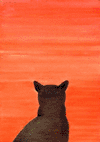 Michael
Harrison, |
||
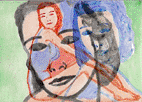 Michael Harrison, |
||
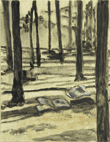 Kendal Heyes, Untitled |
||
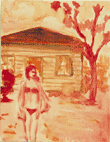 Kendal Heyes, Untitled |
||
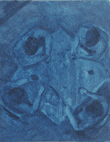 Kendal Heyes, Untitled |
||
Michael Harrison,
|
||
| © The
artists and Images courtesy of the artists. Michael Harrison courtesy of Darren Knight Gallery, Sydney |
||